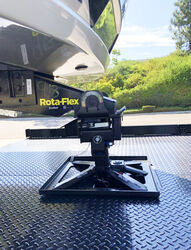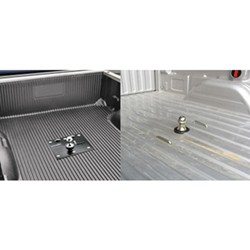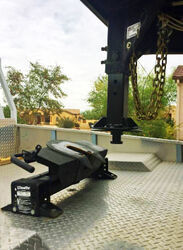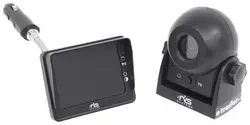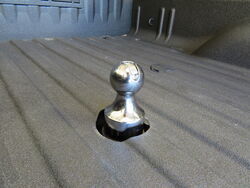

What is a Gooseneck?
If you need a trailer to haul your skid loader to its next job or to get your team of horses to the show safely, a gooseneck may be the next investment for you.
The name "gooseneck" can refer to the trailer, hitch, or both! The gooseneck trailer gets its name from the arching neck of the trailer tongue, shaped like - you guessed it - a goose's neck.
Goosenecks are some of the biggest non-commercial trailers out there. They can be as long as 40' and haul as much as 38K. Gooseneck trailers have 2 or 3 axles that support the bed of the trailer, which means they have a higher weight capacity than your average bumper-pull trailer. They usually come in two shapes: flatbeds or enclosed trailers.
Gooseneck trailers attach to a hitch inside a truck bed. This positions the hitch weight over the truck's rear axle, giving the gooseneck superior maneuvering and strength compared to most other trailer types. Because of this, goosenecks are typically used for hauling livestock, industrial equipment, or agricultural equipment.
The frame rails and coupling point of gooseneck hitches are generally installed underneath the bed of a truck. A ball and two safety chain anchor points are typically the only parts of the hitch visible above the bed after installation.
We get a lot of questions when it comes to goosenecks. Can I install a gooseneck hitch? How much can my truck tow? How do I hook up a gooseneck trailer to my truck?
We'll clear all this up for you below! Let's get started exploring the ins and outs of goosenecks and what they are used for.
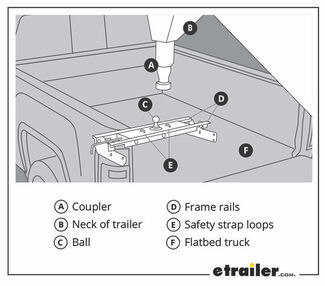
What is a Gooseneck Trailer Used For?
- Livestock trailers
- Horse trailers
- Hauling construction machinery
- Towing agricultural equipment
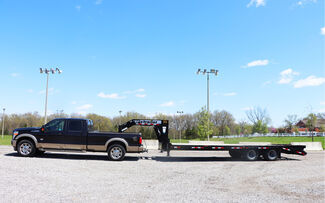
Trucks for Towing Gooseneck Trailers
You may be wondering if your truck can haul a gooseneck trailer. A truck bed longer than 6’ is preferred for enclosed gooseneck trailers such as car haulers and horse trailers. If you have a bed shorter than 6', you may have clearance issues with an in-bed hitch setup. For shorter truck beds, you can purchase an offset gooseneck coupler to safely haul a gooseneck while protecting your truck.
You also need to be sure your truck is up to the task of handling the trailer's weight. The gross towing weight of a gooseneck hitch can range from about 20K to about 38K. Whether you are hauling a tractor or six horses, the most important thing is to determine your truck's towing capacity. You will need a minimum 3/4 ton for anything under 15K and a 1 ton dually diesel for anything over 20K lbs.
If you don't know what your truck's towing capacity is, here are 2 ways you can find it: check your owner's manual or use the formula we will show you below.
Your vehicle's towing capacity can be calculated by subtracting the gross vehicle weight rating (GVWR) from your gross combined weight rating (GCWR). The answer you get is the max gooseneck weight rating (MGWR).
- Gross Vehicle Weight Rating (GVWR): the maximum weight of a vehicle when loaded to capacity. This is not the actual weight of the vehicle, but the weight limit from the vehicle manufacturer that indicates how much your vehicle can weigh in total with all cargo excluding a trailer.
- Gross Combined Weight Rating (GCWR): the maximum weight of your tow vehicle and fully loaded trailer combined.
- Both the GVWR and the GCWR should be on the weight sticker inside the door jamb of your vehicle.
- Gross Towing Weight Rating (GTWR): this is the total gooseneck trailer weight that you can safely tow with your vehicle.
Formula for Calculating MGWR:
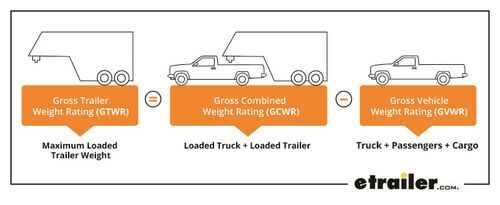
If you have a truck with a gross combined weight rating of 40K lbs and a gross vehicle weight rating of 15K, your max gooseneck weight rating will be 25K.
Types of Gooseneck Hitches
Once you have decided it's time for a heavy-duty gooseneck hitch, you get to pick what kind works best for you. The two main types are below-bed and above-bed hitches. Additionally, you can decide whether you want your ball to store in your hitch, truck, or remain fixed. Let's take a closer look at all these options!
Below the Bed vs. Above the Bed Hitches
With below-bed hitches, the ball and safety chain loops are the only parts of the hitch visible in the bed of the truck. Below-bed hitches are also the most common type of gooseneck trailer hitch, mainly because they allow you to free space in your truck bed when you are not towing.
Above-bed hitches are installed on rails in the bed of you truck. The downside of these type of hitches is that they do not allow access to your entire truck bed because the hitch plate is permanently installed.

Curt Double Lock, Flip and Store Underbed
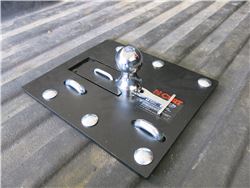
Gooseneck Hitch Ball Storage Options
You have 2 different options when it comes to storage: the ball storing in hitch and the ball storing in a truck. Let's take a look at your options!
Removable Ball - Stores in Hitch
For easiest storage with a gooseneck hitch, a removable ball that stores in the hitch is a great option. When it's time to tow, you can simply flip the ball over and go. This is the more popular option because you do not have to find a place to store the ball when it's removed (and you avoid the risk of forgetting where it's stored!).
The issue you may run into with a ball that stores in the hitch is underbed clearance. For example, you can't store the ball in the hitch on Tundras because of clearance issues. Refer to your vehicle's owners manual to determine whether your truck bed can support a hitch that stores in bed.

B&W Turnoverball Underbed Gooseneck Trailer Hitch
Removable Ball - Stores in Truck
A removable ball that is stored in the truck requires fewer holes in your tow vehicle during installation. However, you'll have to find space in your truck to store the ball when you're not towing — and you run the risk of losing it in the meantime.

Curt Double Lock, Flip and Store Underbed
Gooseneck vs 5th Wheels
You may be wondering what the differences between a gooseneck and fifth wheel are. People often compare them because they both attach to a hitch in your truck bed, but what makes them different?
Goosenecks
Gooseneck trailers are used for agricultural and industrial work because they generally have higher weight ratings. While the ride may not be as smooth as a fifth wheel, these trailers are built to haul heavy loads - not to be lived in.
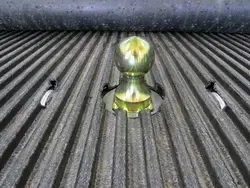
5th Wheels
Fifth-wheel trailers are intended for recreational use. The secure king-pin-to-coupler connection in the fifth-wheel hitch means this type of trailer has a smoother ride than a gooseneck, which is great for hauling an RV. However, the biggest downside of a 5th wheel is that you have to remove the heavy, bulky hitch every time you want to use the truck bed. Overall, these fifth wheels are luxury trailers made for camping, not for working on the farm.
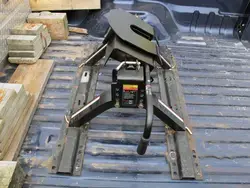
If you want to know more about the differences between gooseneck and fifth-wheel trailers, this article dives in a bit deeper.
If you already have a fifth-wheel hitch but want to tow a gooseneck, you don't need to buy a whole new truck or trailer. You can get an adapter to attach the fifth-wheel hitch to a gooseneck trailer! If you want a hitch that can be used for both recreation and work, read this article for the best fifth wheel to gooseneck adapters.
How to Install a Gooseneck Hitch
Gooseneck hitches are custom-fit products, which means the steps for installing them will vary from truck to truck. You can take a look at our fitguide to see which gooseneck hitches fit your vehicle.
Your options for gooseneck installation are either buying a truck with a gooseneck prep package or installing an aftermarket hitch yourself. You can also buy an aftermarket hitch and hire a professional to install it for you.
The easiest option for installation is buying a new truck with the factory prep package, but this can be a bit pricey. On the other hand, installing a gooseneck aftermarket is doable and affordable with the right tools. Let's take a look at both of these options:
Factory Prep Package (OEM)
When you buy your truck, you may have the option to purchase a 5th wheel/gooseneck prep package. If you choose this option, you can purchase a gooseneck kit that takes less than 5 minutes to install. This kit will work in conjunction with the OEM package to provide the easiest installation.
A big plus of the OEM package is that you won't have to drill any holes into your truck bed. Your truck will already have the proper holes to place the gooseneck ball and chain loops that come in the kit.
B&W Ball and Safety Chain Kit Review
Aftermarket Installation
You can install an aftermarket gooseneck hitch yourself with the right tools and equipment. For a handy person with proper preparation, an at-home installation is a great option. But if you do not have the tools necessary for installing it, you can hire a professional to do it as well. It may even be more economical to buy a hitch aftermarket and pay for installation than to buy a new truck with the OEM package.
You can get a custom hitch that is made to be installed in your vehicle. These attach to pre-existing holes in your truck's frame. While you will need to drill and cut into your bed to make the holes for the ball and loops, you won't need to drill into your vehicle's frame with a custom hitch.
Be sure to take on self-installation only if you have the patience and skill to do it safely. You will have to drill into your tow vehicle's truck bed and dedicate time to getting it done right.
Installing an aftermarket hitch will take you at least three and a half hours. Having two or more people is best when it comes to the installation. It helps to have an extra set of hands to hold up the hitch when it's being bolted under the vehicle.
Proper safety precautions for installing an aftermarket gooseneck hitch include making sure you purchase the correct hitch for your vehicle, reading the instructions, wearing safety glasses, and using reliable equipment. Also never modify your hitch before installation because it could weaken the hitch and your vehicle's frame.
B&W Turnoverball Underbed Gooseneck Trailer Hitch w/ Custom Installation Kit
Installation Steps for Aftermarket Gooseneck Hitches
In order to install a hitch, you will have to measure and drill holes into your truck bed to make room for the ball and safety chain loops. To secure it all together, you will have to bolt the hitch head to the brackets, which bolt onto your truck. And before you are ready to tow, you must install the operating handle and safety chain anchors.
Here's an overview of the steps that go into installing an aftermarket gooseneck hitch. We want to remind you that this is just a general outline - every gooseneck hitch is different, and the process for installation will be too. Be sure to follow the instructions in your owner's manual when installing a hitch.
Read instruction manual Jack up vehicle and set up shop lights Remove spare tire and heat trim Measure hold placement Drill into truck Place crossmembers Prepare truck bed for hitch by attaching any necessary hardware Install gooseneck hitch center section Attach side plate brackets on both sides Torque hardware to amount specified in instruction
Installation Tools for Aftermarket Gooseneck Hitches
To give you a general idea of what tools you may need, we put together this list. This is simply a guideline, so check your instruction manual for a full list of tools you will need for installation.
- Socket set
- Ratchet
- Ratchet extension
- Torque Wrench
- Swivel socket
- Shop Light
- Safety glasses
How to Hook Up a Gooseneck
Hooking up your gooseneck trailer to the hitch requires a lot of accuracy, but is certainly manageable by yourself or with a few friends. Here are the steps that go into prepping your gooseneck trailer for hitching:
- Put down tailgate and line up tow vehicle with trailer
- Back up until coupler is in line with hitch ball
- Lower trailer with hitch jack
- Confirm the coupler is engaged and latched
- Retract jacks
- Attach safety chains, wiring harness, and emergency brakeaway cable
- Test trailer lights
- Safety check
Patience is key when it comes to hooking up a gooseneck trailer. Getting ready to haul a trailer requires appropriate time to prepare and a lot of double-checking. From personal experience, I can tell you that it may take a few tries to get the coupler and ball perfectly lined up.
I always prefer having an extra set of hands to help me while hooking up a gooseneck, but you can also do it by yourself. If you are loading alone, you may have to hop in and out of your truck a few times to check if the coupler and ball are perfectly lined up before lowering it with the trailer.
When backing up your tow vehicle, you can have a friend stand next to the coupler and let you know when it's aligned with the ball. You may also find it helpful to have a Third Brake Light Camera to help you back up safely. This is a handy aid that will give you another set of eyes while lining up your truck with your trailer.
Once you have everything connected, it's important to double-check all of your other hookups to ensure you are ready to safely haul.
Related Articles
Departments
Towing
- Trailer Hitch
- Fifth Wheel
- Gooseneck
- Towing a Vehicle
- Front Hitch
- RV Hitch
- ATV Hitch
- HD Truck Hitch
- Vehicle Wiring
- Brake Controller
- Ball Mounts
- Weight Distribution
Sports and Recreation
Trailer Parts
- Utility Trailer
- Boat Trailer
- Landscape Trailer
- Enclosed Trailer
- 5th/Camper Trailer
- Car Hauler
- Horse Trailer
Vehicle
Contact & Help

What our customers are saying:
"I like the easy of navigation through the site. It only took me a couple of minutes to place my order. Thank You I will shop this sight again in the future."
Popular Vehicles
- Subaru Forester
- Ford F-350 Super Duty
- Ford F-250 Super Duty
- Chevrolet Silverado 1500
- Jeep Wrangler Unlimited
- Jeep Wrangler
- Ram 3500
- Toyota Highlander
- Ram 2500
- Chevrolet Silverado 2500
- Subaru Outback Wagon
- Chevrolet Silverado
- Dodge Ram Pickup
- GMC Sierra 2500
- Ram 1500
- Ford F-250 and F-350 Super Duty
- Jeep Grand Cherokee
- Toyota Tacoma
- GMC Sierra 3500
- Toyota Tundra
- Ford Escape
- More >>


